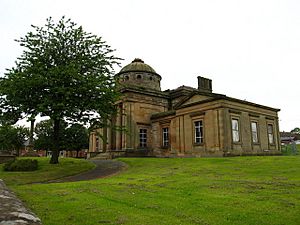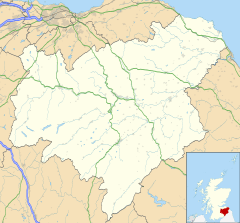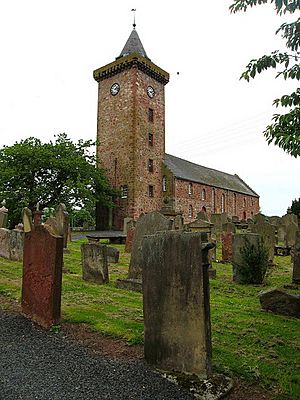Greenlaw facts for kids
Quick facts for kids Greenlaw |
|
|---|---|
 Greenlaw Town Hall |
|
| Population | 600 (2020) |
| OS grid reference | NT710460 |
| Civil parish |
|
| Council area | |
| Lieutenancy area | |
| Country | Scotland |
| Sovereign state | United Kingdom |
| Post town | DUNS |
| Postcode district | TD10 |
| Dialling code | 01361 |
| Police | Lothian and Borders |
| Fire | Lothian and Borders |
| Ambulance | Scottish |
| EU Parliament | Scotland |
| UK Parliament |
|
| Scottish Parliament | |
Greenlaw is a small town and a civil parish in the Scottish Borders area of Scotland. It's located at the foot of the Lammermuir Hills, right by the Blackadder Water river. You can find it where two main roads, the A697 and the A6105, meet. In 2001, about 661 people lived in the parish.
Contents
History of Greenlaw
Greenlaw first became the main town, or county town, of Berwickshire way back in 1596. At that time, the town was about 1.6 kilometres (1 mile) south of where it is today. It sat on top of a hill, which was called the 'Green Law'. This old area is now known as Old Greenlaw.
Greenlaw's County Town Status
In 1661, Greenlaw lost its special county town title to Duns. This happened because of a new law passed by Parliament.
However, in the 1670s, a man named Patrick, Earl of Marchmont took over the Greenlaw area. He really wanted to get back the town's important rights and special powers. He succeeded in 1696! Another law was passed, making Greenlaw the official Head Burgh (main town) of Berwickshire once more.
Over the years, there were several attempts to take the county town status away from Greenlaw again. These happened in 1739, 1790, and 1810. Even though these attempts didn't fully succeed, they set the stage for a new law in 1853. This law allowed important court meetings to be held in Duns as well.
A new courthouse, called County Buildings, was built in Duns in 1856. When the Berwickshire County Council was formed, its first meeting was held in Greenlaw in 1890. But at that meeting, they voted to hold all future meetings in Duns instead.
Even after 1890, Greenlaw was still officially considered the county town. However, the county council met in Duns, and courts were held in both towns. Finally, a law in 1903 officially removed Greenlaw's county town status for good. Duns became the county town for all purposes.
Historic Buildings in Greenlaw
Greenlaw has a beautiful church that was built in 1675. It was constructed on top of older foundations. The special "corbie step gables" (stair-shaped roof edges) show off the building style from that time. The church was made bigger in the 1700s and finished in its current look around 1855.
After Greenlaw became a county town again in 1696, the church tower was designed to be a tolbooth, which was like a town hall and prison. It was finished by 1712. Its style was made to look like a church tower. It's quite unique: it's a square tower that rises about 18 metres (60 feet) high. At the top, it has a special stone ledge (corballed parapet) from which a 5.5-metre (18-foot) tall steeple rises. The old iron gate you see there is the original one from 1712.
A Court House, also finished in 1712, stood next to the tower. So, by 1712, there was a church, a tolbooth (prison), and a court house all together.
A new jail was built in Greenlaw in 1824. It was used for many years but was taken down in the 1960s.
Greenlaw Town Hall was completed in 1831. It's a listed building, meaning it's protected because of its historical importance. It was one of the buildings featured in a BBC TV show called Restoration Village in 2006.
Greenlaw also used to have a golf club. It started in the mid-1920s but closed down sometime in the 1950s.
Facilities in Greenlaw
Greenlaw has several shops for its residents. These include the Blackadder Mini-market, Romanes pharmacy, and Waldie's butchers. There's also a Village Store. The Post Office closed in 2010, but a mobile post office now serves the town. The local branch of the Royal Bank of Scotland also closed in 2014.
Since 1992, Greenlaw has been home to 'STOPS', which stands for the Scottish Theatre Organ Preservation Society. This group created a special building called the New Palace Theatre Organ Heritage Centre. It has a 75-seat hall where you can find famous Hilsdon organs. These organs came from places like the Edinburgh Playhouse and the Picture House in Paisley. People from all over the world visit the Centre. The main organist there, Larry McGuire, helped save the Edinburgh Playhouse from being torn down in 1975.
In 2006, an amateur Weather Centre was set up at the Heritage Centre. The weather information from this centre was put online at bordersweather.co.uk. This website was first made to help visitors know what weather to expect. Now, it's part of a network of weather stations across the UK. Its webcam is watched by many people, especially when it snows!
The person who designed the weather website also started the Interactive Independent Climate Change Project. This project collects weather information from many amateur weather stations around the UK. Some of these stations have been collecting data for over 25 years.
Greenlaw Castle was a large house located to the east of the town. It belonged to a part of the Home family. It stopped being used as a main family home in 1729 and was taken down around 1820.
Geography of Greenlaw
Greenlaw is surrounded by other interesting places. Nearby towns and villages include Eccles, Legerwood, Gordon, Westruther, Polwarth, Fogo, Leitholm and Duns.
Climate in Greenlaw
Greenlaw has an oceanic climate, which means it has mild temperatures and rain throughout the year. There's a Met Office weather station at RAF Charterhall, which is about 4.8 kilometres (3 miles) to the east.
| Climate data for Charterhall (112 m or 367 ft asl, averages 1991–2020) | |||||||||||||
|---|---|---|---|---|---|---|---|---|---|---|---|---|---|
| Month | Jan | Feb | Mar | Apr | May | Jun | Jul | Aug | Sep | Oct | Nov | Dec | Year |
| Mean daily maximum °C (°F) | 6.2 (43.2) |
6.9 (44.4) |
9.0 (48.2) |
11.7 (53.1) |
14.5 (58.1) |
17.2 (63.0) |
19.5 (67.1) |
19.5 (67.1) |
16.9 (62.4) |
12.8 (55.0) |
9.0 (48.2) |
6.4 (43.5) |
12.5 (54.4) |
| Mean daily minimum °C (°F) | 0.9 (33.6) |
1.1 (34.0) |
2.1 (35.8) |
3.7 (38.7) |
5.9 (42.6) |
8.7 (47.7) |
10.4 (50.7) |
10.3 (50.5) |
8.7 (47.7) |
6.1 (43.0) |
3.0 (37.4) |
0.9 (33.6) |
5.1 (41.3) |
| Average rainfall mm (inches) | 57.5 (2.26) |
50.0 (1.97) |
49.2 (1.94) |
48.2 (1.90) |
48.7 (1.92) |
65.1 (2.56) |
70.0 (2.76) |
71.8 (2.83) |
60.0 (2.36) |
80.3 (3.16) |
76.4 (3.01) |
69.3 (2.73) |
746.5 (29.4) |
| Average rainy days (≥ 1 mm) | 13.2 | 10.9 | 10.2 | 10.0 | 10.4 | 10.8 | 11.7 | 11.4 | 10.5 | 12.6 | 13.4 | 13.3 | 138.4 |
| Mean monthly sunshine hours | 58.8 | 80.2 | 124.3 | 167.0 | 188.0 | 193.0 | 177.0 | 169.1 | 139.8 | 99.8 | 78.8 | 50.7 | 1,526.5 |
| Source: Met Office | |||||||||||||
Notable People from Greenlaw
Here are some well-known people who were born in Greenlaw:
- George Linen (1802–1888), a painter from Scotland who moved to America.
- Williamson Blyth (1827–1897), a talented person who made violins, played music, and worked with tin.
- Thomas Gibson (1825–1901), a politician from Ontario, Canada.
- Prof George Gibson FRSE (1858–1930), a mathematician who is thought to be the nephew of Thomas Gibson.



